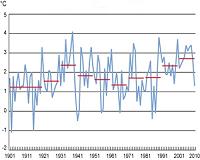| . |  |
. |
Calgary, Canada (SPX) Jan 10, 2011 New research indicates the impact of rising CO2 levels in the Earth's atmosphere will cause unstoppable effects to the climate for at least the next 1000 years, causing researchers to estimate a collapse of the West Antarctic ice sheet by the year 3000, and an eventual rise in the global sea level of at least four metres. The study, to be published in the Advanced Online Publication of the journal Nature Geoscience, is the first full climate model simulation to make predictions out to 1000 years from now. It is based on best-case, 'zero-emissions' scenarios constructed by a team of researchers from the Canadian Centre for Climate Modelling and Analysis (an Environment Canada research lab at the University of Victoria) and the University of Calgary. "We created 'what if' scenarios," says Dr. Shawn Marshall, Canada Research Chair in Climate Change and University of Calgary geography professor. "What if we completely stopped using fossil fuels and put no more CO2 in the atmosphere? How long would it then take to reverse current climate change trends and will things first become worse?" The research team explored zero-emissions scenarios beginning in 2010 and in 2100. The Northern Hemisphere fares better than the south in the computer simulations, with patterns of climate change reversing within the 1000-year timeframe in places like Canada. At the same time parts of North Africa experience desertification as land dries out by up to 30 percent, and ocean warming of up to 5 degrees C off of Antarctica is likely to trigger widespread collapse of the West Antarctic ice sheet, a region the size of the Canadian prairies. Researchers hypothesize that one reason for the variability between the North and South is the slow movement of ocean water from the North Atlantic into the South Atlantic. "The global ocean and parts of the Southern Hemisphere have much more inertia, such that change occurs more slowly," says Marshall. "The inertia in intermediate and deep ocean currents driving into the Southern Atlantic means those oceans are only now beginning to warm as a result of CO2 emissions from the last century. The simulation showed that warming will continue rather than stop or reverse on the 1000-year time scale." Wind currents in the Southern Hemisphere may also have an impact. Marshall says that winds in the global south tend to strengthen and stay strong without reversing. "This increases the mixing in the ocean, bringing more heat from the atmosphere down and warming the ocean." Researchers will next begin to investigate more deeply the impact of atmosphere temperature on ocean temperature to help determine the rate at which West Antarctica could destabilize and how long it may take to fully collapse into the water. The paper "Ongoing climate change following a complete cessation of carbon dioxide emissions" by Nathan P. Gillett, Vivek K. Arora, Kirsten Zickfeld, Shawn J. Marshall and William J. Merryfield will be available online
Share This Article With Planet Earth
Related Links University of Calgary Climate Science News - Modeling, Mitigation Adaptation
 The First Decade Of The 2000s Warmer Than The Preceding Decades
The First Decade Of The 2000s Warmer Than The Preceding DecadesHelsinki, Finland (SPX) Jan 06, 2011 The first decade of the 2000s, or the years 2001-2010, was warmer than the preceding decades in the whole of Finland, even though 2010 was colder than the long-time average. According to the Finnish Meteorological Institute's statistics, the first decade of the 2000s (2001-2010) was the warmest decade in the history of Finland's temperature measurements, which began in the 1840s. The mean ... read more |
|
| The content herein, unless otherwise known to be public domain, are Copyright 1995-2010 - SpaceDaily. AFP and UPI Wire Stories are copyright Agence France-Presse and United Press International. ESA Portal Reports are copyright European Space Agency. All NASA sourced material is public domain. Additional copyrights may apply in whole or part to other bona fide parties. Advertising does not imply endorsement,agreement or approval of any opinions, statements or information provided by SpaceDaily on any Web page published or hosted by SpaceDaily. Privacy Statement |